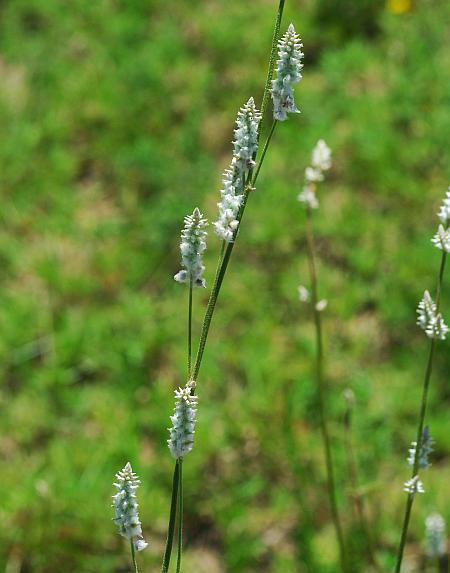Froelichia floridana (Nutt.) Moq.
Field Snake-Cotton

Native
CC = 4
CW = 5
MOC = 23
© SRTurner
Froelichia floridana (Nutt.) Moq.Field Snake-Cotton | |
 |
Native CC = 4 CW = 5 MOC = 23 |
© SRTurner |
|
Family - Amaranthaceae Habit - Annual forb with a sometimes woody taproot. Stems - Strongly ascending to erect, to 1.4 m, relatively stout, sometimes branched, densely pubescent with woolly hairs. Nodes typically swollen.
Leaves - Opposite, positioned mostly below the stem midpoint, sessile or nearly so. Blades 5-14 cm long, the largest 1-3 cm broad, somewhat thickened or leathery, elliptic-lanceolate to oblanceolate, narrowed or tapered at the base, narrowed or tapered to a sharply or bluntly pointed tip, the margins entire, the upper surface densely pubescent with silky or woolly hairs but frequently becoming nearly glabrous at maturity, the undersurface densely persistently pubescent with woolly hairs.
Inflorescence - Terminal, narrow panicles with pairs of dense spikes ascending from the nodes of the main axis. Spikes 1-8 cm long, 10-14 mm in diameter, often short-stalked, the flowers in a dense, 5-ranked spiral. Bracts much shorter than sepals, papery or scalelike, glabrous.
Flowers - perfect. Sepals 5, fused most of their length into a persistent, flask-shaped, papery tube, this 5-6 mm long, symmetrical at the tip, becoming somewhat hardened and developing deeply toothed longitudinal wings and blunt basal tubercles after flowering, white to yellowish white, densely pubescent with woolly hairs, the lobes 1-2 mm long, oblong to lanceolate, bluntly to sharply pointed, greenish white, sometimes pinkish-tinged, more or less glabrous. Stamens 5, the filaments fused nearly their entire length, persistent, the anthers appearing sessile in the sinuses between 5 short, strap-shaped lobes. Ovary ovoid. Ovule 1. Style well developed, persistent, the stigma 1, capitate.
Fruits - Ovoid, hidden within the persistent calyx tube, glabrous, indehiscent, 1-seeded. Seeds 1.5-2.0 mm long, reddish brown. Flowering - May - September. Habitat - Sandy open ground, streambanks, gravel bars, railroads. Origin - Native to U.S. Lookalikes - F. gracilis. Other info. - This tall, willowy species with oddball flowers is found in a few scattered locations in Missouri, most commonly in the Bootheel (Mississippi lowlands) region. Its distribution within the continental U.S. is primarily within the Midwest and Plains states. The genus is easy to identify due to the cottony inflorescences, but differentiation from F. gracilis can be a bit more challenging. F. gracilis tends to be much shorter, with smaller calyx tubes and narrower leaves. The situation is complicated by the fact that the two species sometimes occur in mixed populations, and there is evidence that they can hybridize. Photographs taken in Winter Haven, FL., 6-25-02 (DETenaglia); also at Sand Prairie Conservation Area, Scott County, MO, 07-30-2015 (SRTurner). |